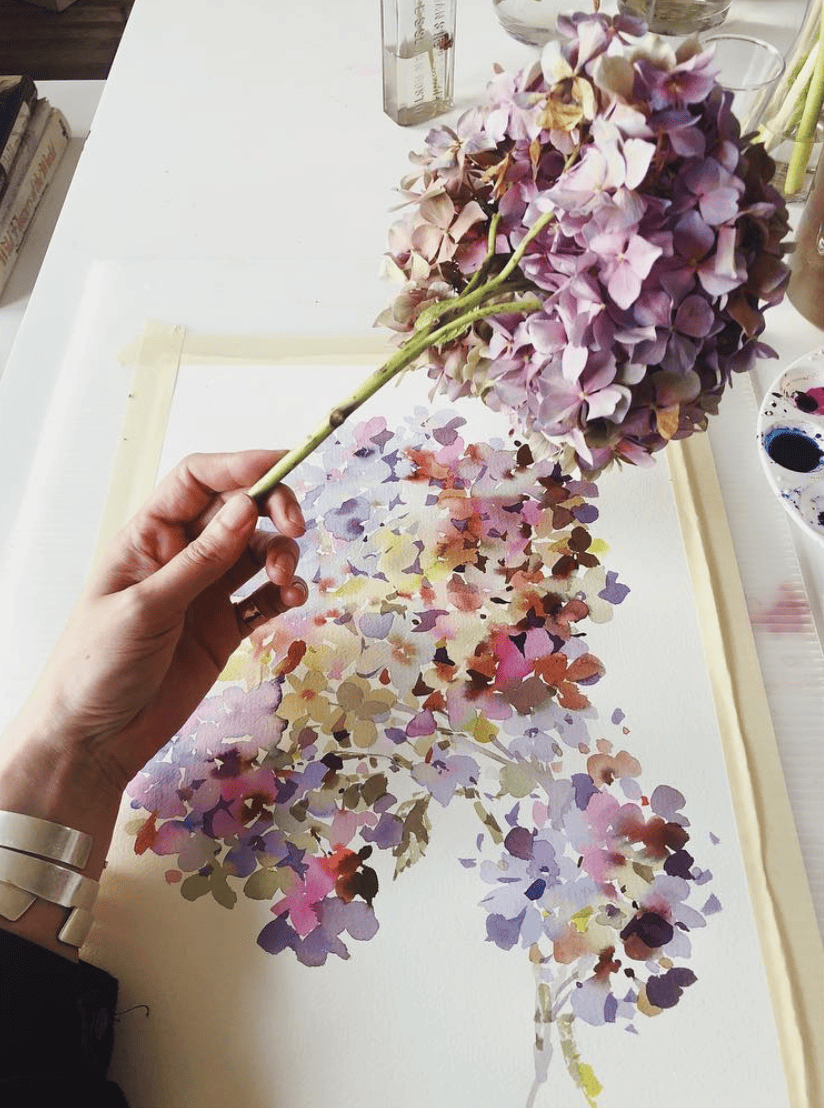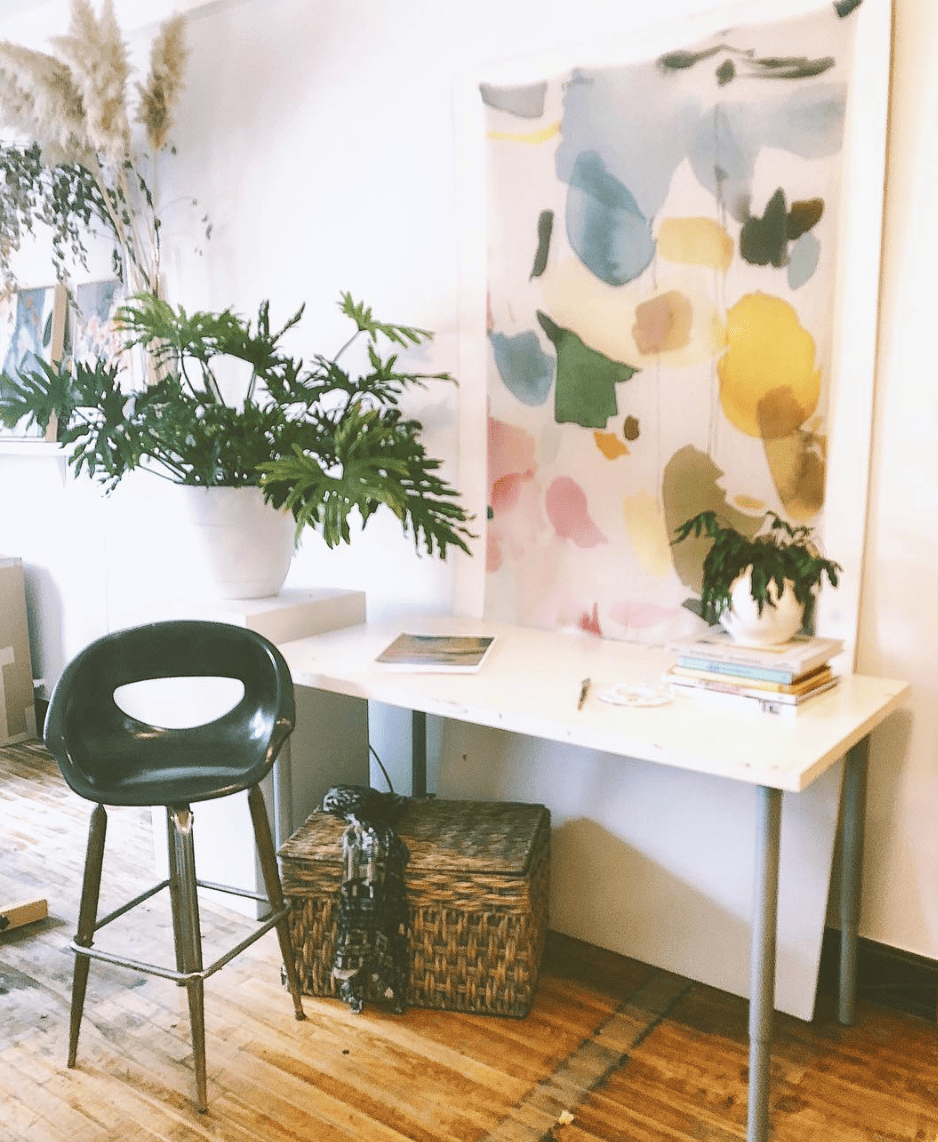
When did you know you wanted to be an artist? Did you go to school for it? What was that experience like? How did it turn into a career?
I’ve always known that I needed to paint. I did go to school for it because the path always seemed pretty clear for me. In the U.K., you can go to College before you head to University. At College, I only really new about the fine artists route, until a teacher told me about textile design when she noticed repetition in some of my paintings. She introduced me to printmaking and told me there were jobs out there in that field. I had no clue! At University, I specialized in Textile and Fashion design at Winchester School of Art in the U.K .
My first job in New York was as a textile designer for the fashion and home markets. This was before digital print design, so everything we produced was painted by hand, with an expectation of, on average, two designs a day. So I got to paint every day and make my living. It was hard work; there were tears in the loo and sometimes at my desk. I was so frightened of ruining a piece that had taken me half a day, that I’d completely be frozen with fear, just unable to move my brush.
Do you think you have to go to school to become an artist?
No, I don’t; being an artist is in us all. But classes and schools allow you the space, equipment and connection to others in the field, which can be an incredibly rewarding experience. It also gives you a starting portfolio of work to show employers. I think the “real world” is the best place to learn on the job. If you can’t or don’t go to school for your art, then the best thing to do is intern/apprentice as much as you can afford to! Be open to doing it all, from the post office runs to the tea making; it all counts!! Above all else, practice and repetition is how we all learn our craft.
What are you most proud of in your career?
I feel proud every single time I work with someone I admire and they are thrilled with the art I make for them. When I feel insecure about my ability, I remember these moments of collaboration, and remind myself that being authentic to my own style and hand always pays off in the end.
Did you have anyone along the way that was instrumental in the trajectory of your life?
There were two people, actually. The first was one of my teachers at University, I was going through some stuff in my home life and she saw me struggling. At the time, her advice felt pretty harsh, she told me to suck it up basically because life goes on. It forced me to focus on making the most of my time there and to think about my future. She saw something in me and in my abilities that I couldn’t see in myself, and I really needed that encouragement. And that kick up the bum!
The second was my friend who convinced me to do a six-month placement in New York City. I didn’t really have the confidence then to take that leap solo, but if I hadn’t, I wouldn’t have had the amazing opportunities I’ve had since I moved to the United States. It’s now my 15th year in New York!
What’s your work space like?
In the last year, I moved from Brooklyn up to Hudson, New York. For about six months I worked in our very wee basement whilst I looked for something locally. Stars aligned and I found my dream space! The studio is a long rectangle divided into two spaces: the larger of the two is my painting studio and I also hold my classes there. The smaller room is where I do my ‘tidy’ work, my computer work, packing orders, etc. The studio has three great big windows and lots of plants. I want it to be a bit of a jungle and Lowes is really helping me with thatJ. It’s so much bigger than my space in Brooklyn, which was about 150 ft.², so for the first couple of months I found myself just using the same amount of space as I had before, like a fish in a tank! It’s taken me a moment to allow myself to accept I could have the whole space.
What’s a piece of advice that you’ve carried with you and who is it from?
“Don’t keep tabs on those you help. It feels much better that way and it all comes back around in the end.” My dear friend Warren Corbitt, a brilliant man I learned a lot from in the five years we shared a friendship and a studio.
What piece of advice would you give to someone starting out in a creative field?
Practice, practice, practice. You know that bit of paper you scribble ideas on when you’re on the phone, the sketchbook you allow yourself to be free in, the piece of paper you ‘test’ paint on? That’s the essence of you and it’s important. Eventually you’ll have the courage to share it and call it your own. Also, get a good bookkeeper.
What does your dream retirement look like?
I’d spend half the year here in the U.S. in Hudson and the other half in my Italian villa on the hill. I recently did a ‘vision painting’ and that’s what came out of it minus a few other details I’ll keep to myself. Plus, there would be many dogs in that retirement picture.
What do you do when someone copies your work?
Oof, that’s tough, and there’s no fast answer. I think my reaction really depends on the way it has been copied and who is copying it. Meaning, if it’s a student or someone just starting out, verses another professional in my field. Also, if the person copying sells the art as their own without crediting being “inspired” by someone else, at the very least, then that sucks. Also, it’s a small world these days with social media, so word gets around fast if you’re a copycat. I usually reach out to the person and start a conversation about how I am feeling and go from there.
Ultimately, I think we are all influenced by each other’s work in one way or another. It really comes down to how one feels about taking from somebody else, I think. It’s moral, and those boundaries vary for everyone. I would feel terrible inside my body about copying someone’s work, so I don’t. I also feel like I’m at a stage in my career where I should be pushing my own abilities and drawing more from internal than external influences. That said, when I try a new technique, I definitely look to artists I admire in order to learn a skill, but I always try to bring it back to my own artistic vision rather than copying what they have done.
I teach classes and so I show students my techniques, but I always encourage taking those techniques and making them their own. We only do ourselves an injustice when we steal another person’s style. And anyway, I believe the true “soul” of art only shines through when it’s authentic to the creator.
What’s inspiring you lately?
The water and landscapes of my new home in the Hudson Valley!
________________________
Thank you, Helen, for your thoughtful words. We loved learning more about you!
You can find Helen:
Portfolio
Instagram
(Download her free poster and bookmark here)









Comments